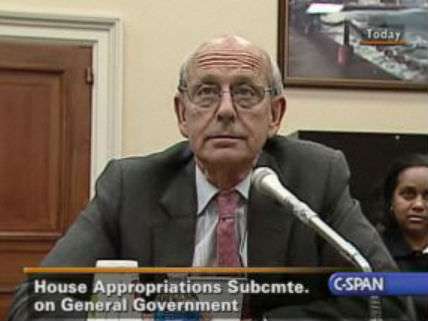SCOTUS Grills Arizona Town Over Treatment of Church Signs
Justices appear to find free speech violation.

The U.S. Supreme Court heard oral argument this morning in Reed v. Town of Gilbert, a free speech case arising from an Arizona town's lopsided regulatory treatment of political, ideological, and directional signs placed on public property.
Up first at the lectern was David A. Cortman, the attorney for Pastor Clyde Reed of Gilbert's Good News Community Church. "The town's code discriminates on its face," he told the justices, "by treating certain signs differently based solely on what they say." As an illustration, Cortman noted that "political signs may be 32 square feet, may be unlimited in number, and may be placed in the right-of-way of the entire town for five months before the election." The signs for his client's church, by contrast, "can only be one-fifth of that [size]," and may only be placed 12 hours before church services are held and must be promptly removed afterwards. "All our argument is," Cortman said, "is that [the town of Gilbert] do it across the board and not treat signs differently based on their content."
Cortman faced no shortage of sharp questioning from the bench. But the morning's real fireworks occurred when the Atlanta lawyer Philip Savrin rose to defend the Gilbert sign ordinance. Once Savrin got started, things quickly went from bad to worse for the Arizona town.
"You are not even purporting to have a content-neutral justification for this," observed Justice Elena Kagan. "You are essentially saying, yes, we generally dislike clutter, but we're willing to make exceptions for speech that we think has special First Amendment significance."
Justice Antonin Scalia raised a similar concern. "Is there a First Amendment right for these other messages or not?" he asked Savrin. "Is there no First Amendment right to give somebody directions?"
But it was Justice Stephen Breyer who most clearly signaled the Court's impatience with the town's uneven treatment of the various signs it regulates:
JUSTICE BREYER: What is this about, this argument? I mean, you agree they can put up a big sign. Can they put up a big sign, ideological, saying, "Come to the next service next Tuesday, 4th and H Streets, three blocks right and two blocks left"? All right? Or are you saying they can't say, "three blocks right and two blocks left"? That's what this argument is about?
MR. SAVRIN: That is what it comes down to.
JUSTICE BREYER: Well, my goodness. I mean -- I mean, on that, it does sound as if the town is being a little unreasonable, doesn't it?
A decision in Reed v. Town of Gilbert is expected by June 2015.



Show Comments (11)